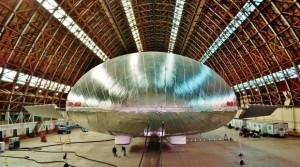Could blimps find a place in Alaska's skies?
by Kathleen McCoy |
This article by Kathleen McCoy was originally printed in the Anchorage Daily News blog Hometown U, on July 27, 2013.
In mid-July, UAA hosted a conference on airships-helium-filled blimps-as a potential addition to Alaska's massive network of cargo transport.
This was the third year for the meet up. Agencies like NASA Ames Research Center and the University of Alaska participated, along with global companies developing airship prototypes. Brazil, Great Britain, Argentina and Russia were all represented, as well as the U.S. military and state and Alaska Native leaders.
The first image that popped into my head was dramatic 1937 footage of the Hindenburg exploding into flames over Lakehurst, New Jersey, killing 36 people and forever chilling an emerging airship market.
But in a weird "Back to the Future" way, proponents argue that updated versions of this early aviation technology might work for 21st century Alaska and other rural areas with underdeveloped infrastructure. How and why?
Transportation costs keep climbing
For perspective, I called the Alaska University Transportation Center (AUTC), the State of Alaska's go-to resource for cold region transportation research. Their website is home to such granular reports as "warm mix asphalt for Alaska conditions" and "seismic performance of bridge foundations in liquefied ground with frozen crust." These are pragmatic engineers firmly rooted in real-world transportation problems.
Rob Harper at AUTC pointed me to a new study the Center and UAA's Institute for Social and Economic Research (ISER) partnered on, looking at the effect of higher transportation fuel prices. He called it a true eye-opener on the ever-rising cost of moving goods to and around Alaska. Every household and every business is affected. No one thinks fuel prices will magically go down again.
ISER economists have often looked at spiking heat and electricity costs, but this was a first on documenting higher transportation costs rippling through Alaska's economy. In 2010, economist Ginny Fay and her study colleagues reported, Alaska's per capita energy consumption tripled the national average.
Alaska fuel prices increased more than 25 percent between 2009 and 2010. Consumers responded by buying fewer cars and airplane tickets. They also paid higher prices for everything they did buy, from food to clothing.
Businesses paid more, too. Fay's study lists the top 10 industries most hurt by higher fuel prices, including seafood, oil and gas, trucking, commercial and home construction, mining-basically, most of the state's economic engines.
To capture impact, Fay highlighted our 2008 consumption habits, before the fuel spike. Had we continued at that rate, she showed that households would have paid $150 million more for gas and transportation. Alaska industries would have spent $500 million more.
Industries that use the most fuel are the hardest hit. In Alaska, that's aviation, which, according to Fay, uses 90 percent of it.
The blimp option
Here's where those slow, graceful dirigibles wedge their way back into our conversation. Being lighter than air thanks to nonflammable helium, and moving much slower than planes, they consume a lot less fuel. One research study done for the military in 2009 compared an hour of flight time in an F-16 ($8,000) to an hour of flight time in a dirigible (less than $500).
Traditional air cargo is the most expensive way to move freight on a fuel cost per ton-mile basis. Fay's analysis showed rail is cheapest, followed by trucks, then barge, marine ships and ferries. But Alaska only has 500 miles of rail. Our ships and barges often leave the state less than full, raising the cost per ton-mile. And we only have two roads, one north and one south. Most of Alaska is nowhere near a road or a coastline. So we're back to air cargo.
Besides lower operating costs, cargo-carrying blimps are attractive because:
- they don't need airports, just a clearing
- they could "island hop" among villages
- they could bring in fuel when it's cheapest or after freeze up
On the other hand, putting a blimp into service is pricey. They range in cost from $30-$50 million, apiece.
Alaska's aging air cargo fleet
Billy Connor heads up AUTC and has studied Alaska transportation issues for more than 30 years.
"Are you in the airship camp?" I asked.
"I am," he answered slowly; the technology is solid and vastly improved. "But what we need to do is stand back and prove the economics. My advanced degrees are all in project management and engineering. You have to ask: Does this make economic sense?"
Connor says his gut tells him airships will pencil out, once Alaskans analyze what they need moved and to where. But first, some brave player has to take the leap.
Those who would benefit the most, remote communities, don't have resources to take the risk. Air cargo carriers working on slim profit margins also fear the risk. Airship manufacturers need assurance they have a market before they can jump.
Connor supports a public-private partnership to spread that risk-and any profit-from putting an airship in service over Alaska.
One other fact matters here, Connor said: Alaska's air carrier fleet will age out in another decade. New restrictions prevent Lockheed from building any more of the classic air cargo workhorses, C-140s, for civilian use.
"They've got 10 years to figure it out," Connor said of the air cargo carriers. "That's one reason they're so interested."
 "Could blimps find a place in Alaska's skies?" is licensed under a Creative Commons Attribution-NonCommercial 4.0 International License.
"Could blimps find a place in Alaska's skies?" is licensed under a Creative Commons Attribution-NonCommercial 4.0 International License.















